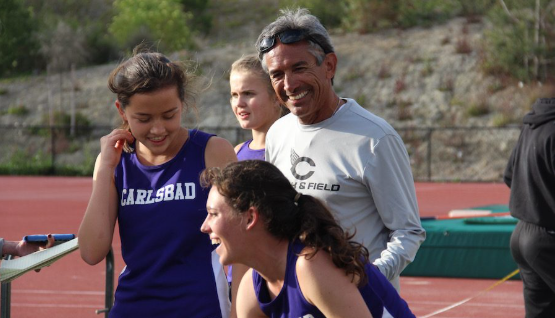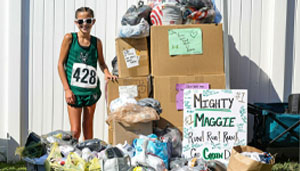Transitions to a High School Track or Cross Country Program
By Jeff Arbosgast on October 30, 2014 coaches PrintOne of the greatest thrills for a high school coach is the prospect of working with a new season full of eager and talented athletes each year. Student-athletes with hopes and goals mix annually with the 'old guard'; juniors and seniors who can forge the excitement into the reality of what it takes to become a contributing member of a competitive team.
The incoming athlete may have had some experience at a youth track level, perhaps even some success, but this new environment in high school offers challenges that every young athlete – whether recreational participant or Junior Olympic Champion – needs to understand.
All through a track competitor's career, new levels of competition keep emerging, starting with youth cross country and track, perhaps followed by high school competition, and, for a select few, a college career exists. In rare cases, the level rises again as women and men qualify for national teams and compete on a world level. Regardless, each new level of competition requires an understanding of what makes it different from each level before it.
In youth track, mom and dad pack up the car and make a day or a weekend out of participation in a meet, perhaps regional or national in scope, but more often than not, a low-key event where participation is key and competition is a side-benefit. If you are lucky, the coach understands the training and competing concepts applicable to the athletes’ ages, and they mature physically and mentally into well-rounded competitors. In other cases, a coach may have the dual role of parent, depending upon the local emphasis. Participation is key, learning is invaluable, and the fun of event exploration fuels the young athlete.
But now the obvious differences in programs are apparent. The local paper doesn't just feature the agate scores and marks of the local USATF Meet, but instead runs a story on the regional champion who broke 12 seconds in the 100 meters at the high school conference meet, or the boy who broke a school record in the shot put and discus in the same year.
This new arena – high school – seems to be where all of the athletes come out to test their skills, whether the product of a tremendous youth program or relatively inexperienced but possessing uncanny natural ability. Athletes look at this new level and wonder how well they can compete. They have a tremendous advantage, but also a liability. They have developed experience that will help them hold up under high school workouts, but also have some pre-conceived notions of what to expect that can get in the way of true enjoyment of the sport.
Hopefully, athletes enter a program that will allow them to continue to develop to their fullest in a physical and competitive sense. Most high school programs have solidly trained and interested coaches who will allow athletes to excel, but coaches’ goals for athletes will change to a higher step, reflecting their understanding of newer and loftier opportunities to run, throw and jump at performance levels athletes may have not yet dreamed of. What can athletes do to make the most of this experience? Here is how athletes must adapt to a new coach and school:
- Understand that for perhaps the first time, the concept of 'team' will enter into many aspects of what they do competitively. They may need to work on a secondary event, run a leg of a relay they have never run before, or adjust some of their workout to fit into a larger plan. This is normal and an honor in most cases. Athletes at an international level do it often.
- The joy of performing well is now shared by the team they train with that represents a school. Individual performance and personal bests are still important, but they also have fun contributing to a team score, a team record and a team history.
- The competitive nature of high school track or cross country is much higher. This presents opportunities to demand more of athletes on the track and the field, but also gives them chances to make long-lasting friends with competitors on a team. Expect that no competitor will give athletes an advantage on the track or field, but most all will share an energy bar with them after the event.
- Physical workouts will step up in intensity to match the higher level of competition, but school and social demands will increase as well. They must learn to balance and manage time as well as set priorities to accomplish school goals, family goals and competitive goals.
- In youth track or cross country, parents could devote their entire attentions to their careers. In high school, to get the same type of attention, athletes will need to initiate communication often. They must not be afraid to talk with the coach. Communication is the key to improvement in the high school environment.
- Re-structure their personal goals and evaluate them often and honestly. Set 'stair-step' goals with realism and reward them when they attain small achievements. Have them try to score in a JV meet, clear an opening height in a varsity competition or throw far enough to get measured in a regional meet. High school athletes have far more fun when they confront the 'learning and training curve' with reality, and delight in small successes on the way to big achievements.
- Athletes should become a student of their event! The days of relying on adults to direct every move in athletics are now gone. An intelligent athlete who understands his or her sport is an asset to a high school program. She or he can self-diagnose minor injuries, communicate difficulties in training, or respond with suggestions based on understanding elements of training which have been left up to others until this time. They need to study, read and ask questions often.
- Athletes should become self-reliant in their preparation. The large nature of many teams requires a coach to focus attentions on a bigger picture. Athletes can keep a checklist of all their pre-race necessities, set multiple alarm clocks, tape a meet schedule and order of events to the inside of a locker, and keep plenty of essentials in a gym bag for any eventuality. A coach will value their preparedness since mom and dad are now watching from the stands.
High school track and cross country will provide the most enjoyable competitive experiences they will ever have in the sport. Regardless of whether their career continues after this level, they will always look back to these days as the most fun times they ever had, and the best learning opportunity possible. A smooth transition from youth track and cross country to a more intense level of competition will help them to hit goals, make an impact, and continue to improve at a much faster rate.
Some athletes will fall by the wayside as this new level of competition presents challenges that seem too difficult, but understanding new opportunities and responsibilities will help them mature into a competitor, a leader and a valued asset on any high school team.
Jeff Arbosgast
Jeff Arbogast has been the boys and girls cross country coach at Bingham High School in South Jordan, Utah, for the past 31 years and the boys and girls track teams for 29 years. He has led his teams to 10 state championships and annually has one of the nation’s top cross country programs. He has served on the NFHS Coaches Publications Committee since 2003 and currently serves as chair.
Most Recent Articles
- nfhs news NFHS Learning Center Delivers 25 Millionth Course
- Track & Field/Cross Country article Effective Communication with Athletes and Coaches
- nfhs news Player Equipment Changes Highlight 2025 High School Football Rules Revisions
- Player Equipment Changes Highlight 2025 High School Football Rules Revisions
- nfhs news Judgment Call on Second Contact Eliminated in High School Volleyball






